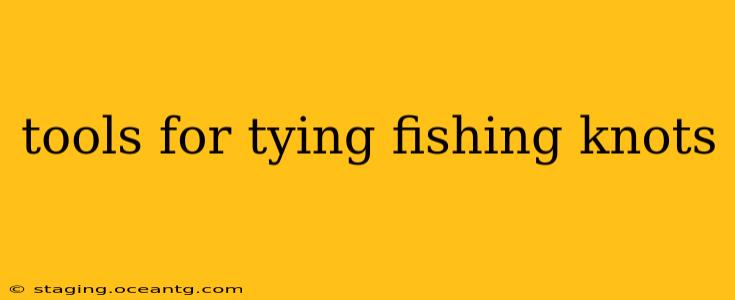Tying the perfect fishing knot is crucial for a successful fishing trip. A strong, secure knot prevents line breakage and lost fish, maximizing your chances of landing that trophy catch. While your hands are the primary tool, several other aids can significantly improve the knot-tying process, especially for beginners or when dealing with slippery lines. This guide explores the essential tools that can elevate your knot-tying game.
What are the Best Tools for Tying Fishing Knots?
Many anglers rely solely on their fingers and thumbs, but incorporating a few tools can make a huge difference in knot quality and efficiency. Here are some of the best options:
1. Knot Tying Tools: A Game Changer for Beginners
Specialized knot-tying tools are designed to simplify the process and ensure consistent results. These tools often have grooves or clamps to hold the line securely while you manipulate it, particularly beneficial when dealing with fine or slippery lines like fluorocarbon. They provide a significant advantage for beginners learning complex knots. Look for tools that are durable, easy to clean, and comfortable to hold.
2. Line Clippers or Scissors: Essential for Neatness and Safety
Sharp, high-quality line clippers or scissors are vital for trimming excess line after tying a knot. A clean cut prevents frayed ends that can weaken the knot and cause it to fail. Keep your clippers sharp for a precise cut; dull clippers can crush the line, further compromising its strength. Consider carrying both a pair of clippers and scissors – clippers for cutting thicker lines and scissors for more delicate work.
3. Magnifying Glass: For Those Tiny Knots and Fine Lines
When working with thin lines like 4-pound test or smaller, a small magnifying glass can be invaluable. It allows you to see the details of the knot more clearly, ensuring every loop and wrap is correctly positioned. This minimizes the risk of tying a weak or insecure knot.
4. Waterproof Knot Tying Instructions: Always Have a Reference
While memorizing knots is ideal, keeping a waterproof card or small booklet with clear diagrams of your favorite knots is a good idea, especially when faced with challenging weather conditions. This reference allows you to quickly check your work and ensure the knot is tied correctly, preventing frustration and potential loss.
Frequently Asked Questions (FAQs)
Here are some common questions anglers have about tools for tying fishing knots:
Do I Really Need Special Knot-Tying Tools?
While not strictly necessary, knot-tying tools can significantly enhance the process, especially for beginners. They offer better control over the line and help create tighter, more secure knots, particularly crucial with fine lines. For experienced anglers, these tools might enhance speed and efficiency.
What's the Best Way to Clean My Fishing Knot Tying Tools?
After each use, clean your tools with fresh water to remove any salt residue or debris. For knot-tying tools with moving parts, occasionally lubricate them with a light oil to prevent rust and ensure smooth operation.
Are There Any Knots That Are Particularly Difficult to Tie?
Some knots, like the Albright knot or the Bimini twist, require more practice and precision than others. Using appropriate tools and having a clear reference can make these more complex knots easier to master.
How Can I Improve My Knot-Tying Skills?
Practice is key! Start with simple knots and gradually move to more complex ones. Use a variety of lines and practice in different conditions. Investing in the right tools and having a reliable reference can significantly improve your technique and confidence.
By using these tools and techniques, you'll be well-equipped to tie strong, reliable knots that will help you land more fish. Remember, a secure knot is the foundation of a successful fishing experience.
